Entries from Expedition Dispatches
This is Seth checking in from 7,800 feet on the Kahiltna Glacier. Today we awoke to clear skies in the Alaska Range. It was great to have a 'normal' day after a whirlwind start to our trip. Yesterday was supposed to be our packing day in Talkeetna but we had an opportunity to fly in the evening so we decided to go for it and now we're a day ahead of schedule. After a breakfast of bagels and smoked salmon we spent 5.5 hours on the trail. We then enjoyed some warm weather while we had dinner in camp. Now the sun is behind the mountains and everyone is tucked in their warm bags. It's been a great start to the trip.
RMI Guide Seth Waterfall
As Dave Hahn wrote yesterday, my attempt at trying to climb this monster called Mt. Everest is over. I wanted to write today about what went into that decision.
Over the past several weeks we have made several "rotations" on Mt. Everest to higher and higher camps and elevations. During these rotations I have felt quite strong for the most part, and in fact, our entire team has been strong. One of the keys to climbing this beast is that the group work together, and move efficiently and rapidly through the most dangerous parts of the mountain. We have in fact been doing that.
One of the key objectives of our rotations is to acclimatize. What this means is to allow the body to adjust to higher and higher altitudes by moving up the mountain slowly, by climbing "high" and then sleeping at a lower altitude, and then descending to a lower altitude (Everest Base Camp) and starting the pattern all over again.
About a week ago I started to notice that my body was not acclimatizing like the other members of the team beginning at about 22,000 feet. At night at this altitude, when I was attempting to sleep, I would be drifting off to sleep and then I would have to sit up and gasp for air. I would then pant for a minute or two, and then the entire process would repeat itself. This occurred for 4 to 5 nights ALL NIGHT LONG. I tried Diamox (a medicine used for acclimatization), but it didn't help me. During these nights I would look over at Sara (my daughter) who was restfully sleeping in her sleeping bag, and curse her (just kidding).
At about 22,000 feet my body simply stopped acclimatizing like it had been from the beginning of the trip. The result of this was that during the day I would not be rested. During our climbs I would be panting hard, and I would be slower than I had been, and now slower than the rest of the group. I tried hard to figure out how to sleep and get my acclimatization going again, but I just couldn't do it. I was getting weaker (not stronger like the rest of my teammates) every day above 22,000. Sara, on the other hand, would be getting stronger each day that she spent up there. I told her she was never going to get a car and she was grounded (just kidding again).
After our last rotation we returned to Base Camp. I went to bed and woke up LIKE A NEW MAN. Simply descending to Base Camp (which is still at 17,500 feet) allowed me to get a 10 hour night sleep, the first night sleep I had in 6 days. I slept like a rock, and I felt great (and feel great right now). So it's a weird feeling to be sitting at Base Camp, feeling extremely strong, and yet knowing that my attempt at the summit is over.
But, I made the decision that my attempt to climb Mt. Everest is over, and I know it's the correct decision. And here are my considerations:
1. I do not want to be a burden to my teammates. I think the hardest decision a person can make is to evaluate himself (or his children). It is very difficult to make these comparisons. I feel that I am a strong climber below 22,000, and still, above 22,000, I still think that I am an "okay" climber. I can climb forward past many people on the trail, but still, I can not keep up with my teammates, and I can not climb the tallest mountain in the world. These are tough assessments, but must be done honestly and candidly (so, next time one of your kids is cut from a team let it be known that I CUT MYSELF FROM MY OWN TEAM!)
2. This mountain is over 29,000 feet tall. At Camp 2 I would still be 1.5 VERTICAL MILES below the summit. If this mountain were 24k or 25k feet tall there is no doubt in my mind I would make myself summit. But, this is a monster. I have no interest in "high pointing" at Camp 3 or Camp 4. If I can't climb this mountain to the top, then I am done.
3. Sara. I am not simply a member of a typical team of, say, 8 guys. I am also the father of another member of this team. Another consideration that I must always have is what is in the best interest of Sara. And that's easy - to eliminate from the team its weakest member (me) that might cause the team to move slower, or - if I pushed myself beyond my limits - that might cause the team to have to stop to medically rescue me off the mountain. I know that with 6 professional members of our team, and one client (Sara), that, with me dropping out, Sara is in a better place. She will have an entire team of the best climbers in the world working with one client - her.
4. People die on Mt. Everest every year. It's a brutal, unforgiving place. There are many motivations for climbing this mountain (ego, personal challenge, etc.) and sometimes those motivations drive people to ignore the signs that their bodies are giving them and then they push themselves well beyond their limits. Its protocol in these blogs not to write about what you see on Mt. Everest. There are many other teams, many other climbers, and many other people making decisions about whether to proceed with their climb or to end it. Many continue to keep climbing. I am choosing to make sure that I don't die on Mt. Everest. I have a great family, great friends, and a great community, (and many things to do with the rest of my life) and I am looking forward to all of these things in the years ahead.
Dave Hahn and Linden Mallory are terrific guides. Dave has made this my decision, and has said repeatedly that I can "take another shot" and I can keep climbing (this trip is pretty expensive). But there really would be no purpose to trying again. I have been up to about 22,000 feet before and have struggled beginning at that altitude. Before this trip I thought that it was other factors that caused my lack of acclimatization (lack of water, not eating enough, etc.). But now I know that my body is just not made for climbing 8000 meter peaks.
I have climbed a lot of tall mountains (Aconcagua, Denali, Kili, etc..) and I really enjoy the experience. But if you hear of me planning to give an 8000 meter peak another try please GRAB ME BY ME ANKLES and stop me. My body is just not built for it.
I will be hanging out in Base Camp for the next 3 weeks (like a parent on the sidelines at Tophat) cheering on my daughter and the rest of the team. There are many things to do at Base Camp - last night I lost in Jenga, but came in second in a big Yahtzee tournament. And most every night there is a late night poker game (guides from many teams and countries like to play Texas Hold em, it turns out). And I am surrounded by the tallest and most beautiful mountains in the world. So, all is good here at Everest BaseCamp.
I am disappointed that I will not get a chance to summit, but I am happy that I made this journey, that I made it with my 16 year old daughter, and I wouldn't trade it for anything. I will remember it forever.
Love and peace to all.
Bill M.
Everyone (and their baggage) arrived on time in Anchorage yesterday, and we headed north to the small town of Talkeetna. We had a relaxing evening, eating dinner as a group at the famous West Rib Pub, talking about the trip, and getting to know each other. This morning we met at the the Talkeetna Roadhouse for a group breakfast to formalize our plans for packing and preparing for our upcoming expedition. Talkeetna is a small and unique town; situated on the south side of Denali National Park, it is the staging point for hundreds of climbers who venture into the Alaska Range. Town is still sleepy this time of year, just coming out of its winter hibernation; the streets are quiet, few airplanes are in the air, and patches of snow are still in the yards. When we return in a few weeks, Talkeetna will be in full swing; tourists and climbers will be walking through the streets, the air will be filled with the buzz of single engine aircraft (and mosquitoes), and all of the trees and lawns will be green.
Most of the day today was spent at the hangar of our bush pilots, K2 Aviation, packing our gear and going over all of our equipment. While we all have spent months planning this trip, today was still a very busy day making sure we had the right gear for the trip, inspecting our tents and stoves, and double and triple checking everything.
We also met with a National Park Service climbing ranger for a formal orientation to Denali, which included a slide show of our climbing route.
We plan to fly into Kahiltna Base Camp tomorrow (weather permitting) to start our adventure. We will be in touch with detailed dispatches throughout the trip. Everyone says hello to our friends and loved ones back home. Here’s to a safe and successful trip!
RMI Guide Mike Walter
A hot shower... Cotton clothes... Chairs with backs... An appetite... Easy temperatures... Brain temporarily free of Icefall fixation...
Must be rest day #1. Still decompressing from the last week on high and not yet laser-focused on the coming week, which will be higher still. I am tempted to call the past week a good one, since we each came down healthy and with some clarity and confidence as to what will be next, but to be honest, it was a tough week in several ways.
While things went as planned for Sara, in that she got stronger and more acclimated with each day of the past rotation, that wasn't the case for her Dad. Bill, although strong and fit, was hitting some sort of personal limit in living at Advanced Basecamp and venturing to around 22,000 ft. Ultimately, we chose to get Sara the experience she needed on the Lhotse Face while her Dad stayed below. We knew eventually that we'd need to reformulate a plan for going ahead with the expedition.
Sara did climb well and strong with me to 23,000 ft a few days back. She didn't seem particularly fazed by the massive exposure and steep angles. She did a good job dealing with the distraction of other climbers (mostly Sherpas going fast up or fast down) needing to pass on the fixed ropes and a single set of steps chiseled in the ice. She didn't seem any more bothered than I was by the novelty of two helicopters hovering a few hundred meters away on some rumored film project. Sara kept concentrating on clipping her safety gear past anchors and on setting her crampons securely and on breathing steadily with each new step even though she knew a medical emergency had taken a man's life just the day before on these same ropes and in these same footsteps. Many of the Sherpas and guides we met and spoke with had some involvement in trying to mitigate the sad circumstances of the day before and it was impossible to be so high on the world's fourth highest mountain without dealing with some heavy and sad thoughts on mortality. This was balanced by the incredible beauty and expanding horizons we were granted as we climbed higher... Everest, our next door neighbor for now, just kept getting more magnificent... Until it developed a bad case of snowclouds, as did Lhotse. Although we were in view of the first tents of Camp 3, which would have made a fine goal for the day, it seemed best to turn and get a little experience descending the steep face with a little less snowfall and associated sluffs streaming down the face. At our highpoint, I pulled my GPS from a pocket and we established that Sara had just crushed her previous altitude record from her climb of Aconcagua several years back. We "arm rappelled" back down the face and tiptoed on crampon points to get across the steep bergschrund at it's base. Then on easy angled glacier again, we made excellent time down to where Bill and Linden had come out to meet us above ABC.
Yesterday morning we dodged a few more snow squalls and dodgy snow bridges and we even spied a spectacular avalanche off the side of Nuptse during our journey from ABC to Everest Base Camp. It all seemed eventful and a little crazy and excessive, to be honest. Lam Babu and Uberaj joined us for the walk to Base Camp and Kaji and Dawa went all the way up to ABC with heavy loads and still caught us before we exited the Khumbu Ice fall on the way down. Tcherring and Tuck were in camp to greet us with smiles and handshakes and... even better, Kumar greeted us with lunch. We were tired but quite happy to be down.
Today, we sat together and developed that new game plan for the coming weeks. Bill won't climb up with us on these next rounds... he won't go for the summit and Sara will. It isn't what we wanted going into this expedition, but it seems like the smart plan under the circumstances. Bill will write of his thoughts on the matter in coming days.
Best,
RMI Guide Dave Hahn
The team completed their second rotation at Camps 1 and 2 and returned to Everest Base Camp today.
We are glad to have everyone back down to rest and recuperate from their time up high. Even Yubarj, our Camp 2 cook, returned to Base Camp for a few days break.
Nobody will be heading out of Base Camp going up hill tomorrow from our camp so we are heading to bed tonight without setting the alarm. That is a nice feeling.
The team is looking forward to a warm shower and we are looking forward to hearing their stories from the last few days.
It was a nice day today here at Base Camp and I headed down valley for a little bouldering.
Once the team is rested we'll get them sending some dispatches with news about the last rotation.
Till next time,
Mark Tucker
The weather here at Everest Base Camp at 4:30 a.m. was snowing hard, so Dawa and Kaji decided not to carry loads to Camp 2.
Up at Camp 2 the snow was not so heavy, so Dave, Sara, Linden and Bill left toward the Lhotse Face at 7:15 a.m. After four hours and twenty-five minutes of uphill climbing Sara and Dave crossed over the 23,000-foot mark. Dave reports a great day of training, getting used to the steep terrain, and working with other teams on the face. This sort of familiarity will help them get to Camp 3 in good shape. The knowledge and technical expertise gained on these practice runs is invaluable. Linden and Bill turned around a bit before, and supported our two high altitude mountaineers back at C2.
While they were all together early that day, we had support from Lam Babu and Yubarj listening in on radio transmissions from Camp 2. One more night at Camp 2, then back to EBC for another rotation of rest.
Looking forward to seeing the team tomorrow.
Till next time,
RMI Guide Mark Tucker
Hey Jim Whittaker! Happy 48th Anniversary of the first American on the summit of Mount Everest.
Nobody from any country is on top May 1st this year. Steady progress is being made in that direction, but I would think even with perfect conditions ahead, it will still be another week before anyone summits.
The Whittaker family is a big part of RMI. Jim's twin brother Lou, being the Chief Guide of RMI for years. His son Peter leading the charge at RMI now, and his brother Win involved in the family business as well. Last year I worked with Jim's son Leif on his climb of Everest.
On Jim's summit day he had a Sherpa climbing partner named Nawang Gombu. Gombu, as we all called him around Mount Rainier, would work the summers with us on Rainier. He was the youngest member of the 1953 expedition which made the first ascent of Mount Everest. In 1965 he reached the summit again, becoming the first person to climb Mount Everest twice. It was always a pleasure to work with him on the mountain. Just the nicest guy, and anybody who was lucky enough to climb or spend time with him, new they were touched by a very special man. I received the sad news of his passing last week. He will be greatly missed.
I had the honor of being part of the 1990 Mount Everest Peace Climb led by Jim Whittaker. Our goal was to summit on April 22, the twenty year anniversary of Earth Day. We did not get our first team to the summit until May 6th. Point being, that without much fixed line, and that early in the season, our hats go off to you Jim, for an amazing accomplishment.
We should all be so proud of our team, for the respect they are showing to Jim's mountain and the effort put forth to preserve his legacy.
Dave and crew did another climb up to the base of the face and back to Camp 2 for the night, they plan to give a go at the Lhotse Face tomorrow. Rest today for the Sherpa team, but just handed off supplies to be taken to Camp 2 tomorrow.
Till next time,
RMI Guide Mark Tucker
The weather could not have been better last night and early today. Right now it is snowing lightly. It can sure help to have stable weather conditions for any night at 21,300' and a major bonus to have calm weather for the first night of many at that altitude. The word from above is that the team did well during the night. So well in fact, that Dave was able to rally the team early this morning for a 7:30 a.m. departure and climb to just below the Lhotse Face. That section took about an hour and forty-five minutes. We would call that part of the day, the approach to the climb. Above where they stopped is a continuous steep climb to get up to Camp 3, which sits at 23,900' more or less. Dave reports that since we have been having daily snow, the conditions on the face have improved. What we saw in the earlier part of the month was blue ice on most of the face.
The previous dry winter has created a big gap between the lower angle slopes and the steep face, which is referred to as a bergshrund. If it were a wet winter with lots of snowfall, that gap could be filled in with snow making crossing much easier. At the last meeting of the teams, we decided to send up a ladder to be placed in that area if it seemed like it would help the climbers get on to the steep section. More progress was made by the fixing team above Camp 3. Sounds like the ropes are set to Camp 4, which is the South Col (26,000'), our final camp before the summit push. More work will be needed to improve the ropes from Camp 2 to the South Col but that is huge to have the initial set in place. Dave, Sara, Bill, and Linden plan on getting on the face tomorrow. This will be a taste of steep climbing at extreme altitude.
The team is right on track and fired up!
Till next time,
RMI Guide Mark Tucker
The team climbed from Camp 1 up to Camp 2 (ABC) today in perfect conditions. They will stick to the rough outline for now spending three or four nights at Camp 2. While at Camp 2 their main objective is taking care of themselves by eating, drinking and resting. Over the next couple of days they will climb towards Camp 3 to stretch their legs and lungs and keeping with the climb high, sleep low philosophy.
Everyone is doing well and we look forward to seeing them back in Base Camp in a few days.
RMI Guide Mark Tucker
The Nisqually Glacier is the most easily viewed of all the glaciers on Mt. Rainier. Facing the Paradise Visitor Center, it runs four miles from the 14,410-foot summit down to about 4,500 feet in the Nisqually Valley. At about 12,500 feet the ice forms a giant cliff where the glacier breaks apart over a large rocky step and smashes itself back together 1,000 feet below. Usually unskiable, the heavy snows this winter have filled in one side of the cliff and a continuous line appeared, begging to be skied.
My friends Tyler Jones, Andy Bond and I had a random convergence in the Northwest after being on separate agendas for the winter. Tyler had been ski-guiding in La Grave, France, Andy spends his winters in British Columbia, and I had just returned from a trip to Haines, AK. Andy had recently been bombarding me with emails about how the ski conditions on Rainier were about to 'go off' so we all met up in Ashford, WA, to wait for some good weather.
After a few days in town, the necessary conditions stacked in our favor, and we took the opportunity to pull off a big line on Rainier. In the Northwest, a full winter of storms on an endless conveyor belt had been pounding the mountain with snow. Now, with an approaching high pressure system, we had a few days of guaranteed sunny weather. So on Thursday, April 22, we left Paradise in a snow storm hoping that the forecast would pan out as advertised and once at Camp Muir the weather would break. Typically we could each do the trip to Muir without the aid of GPS in any conditions. We have over 200 summits of Rainier between the three of us. But this year every landmark is covered in snow, making navigation impossible without the aid of electronics. A quick consult with the GPS was all we needed to find our way to Muir.
Once there, we packed into the tiny RMI hut that normally sleeps two. Poor Andy had to sleep on three coolers; it was either that or the snowy floor. The weather was pretty cold most of the night so there was no rush for us to start climbing until the sun came up. To our surprise there was another party climbing that day. They had left about an hour ahead of us and it was nice to follow their track for the first part of the day. We climbed up towards the Gibraltar Ledges route. This gave us a great vantage point of our desired ski route and I was able to take some pics in case we needed to use them as a quick-reference guide on the descent.
Once we caught up to the other party, we took our turn breaking trail towards the summit. Conditions were great and we were able to make quick progress to the top. Our total climbing time from Camp Muir was four hours on the dot. Not bad for carrying skis on our backs! On top we spent some time checking out the different aspects of the mountain and taking photos of the gargoyle-like features of rime-ice; created as water vapor from the recent storm cycle beat against the mountain, freezing instantly. The wind was howling, so soon after, we clicked into our skis and started downhill towards the top of the ice cliff.
The upper part of the mountain skied nicely. Rainier is like a big dome and the upper reaches aren't extremely steep and the snow was firm but edge-able. Once we dropped about 1,000 feet, however, the slope angle increased dramatically and the snow became even more firm. At 13,000' we could see directly down the glacier to the top of the ice cliff. From here we were committed, and any slip could result in a long slide off the cliff. Precise, controlled ski turns were necessary and we skied one at a time in pitches to keep an eye on each other.
The line through the ice cliff was fairly straight forward. We trended gradually right, through an ever narrowing gap between big rock cliffs and the edge of the ice. The snow conditions steadily improved as we dropped lower on the mountain. In total we skied about 3,500 feet of terrain in what we considered a "no-fall" zone. The stress of all the exposure relented bit-by-bit as we descended, and by the time we exited the ice cliff section we were relaxed enough to fully enjoy the pitch out from under the cliff.
We then threaded our way out of the large amphitheater formed by the ice cliff and through a myriad of crevasses onto the benign slopes of the Muir Snowfield. There were several groups of skiers there enjoying the fresh powder and sun. We stopped to chat before continuing on our way and they congratulated us on our journey. The snow was so good from here that we decided to drop below the elevation of the parking lot all of the way to the Nisqually Bridge at 3,500 feet. We knew that this could mean a long wait for a hitch hike back to the car but the day was going too well to worry about that. Plus, the lure of getting the longest ski run in the 'Lower 48' on top of a new route on Rainier was too much to resist.
I think we waited for a total of 15 seconds before a really nice guy from Fort Lewis Army Base gave me a ride back to Paradise to get my car. Our luck was good all day!
Previous Page
Next Page
















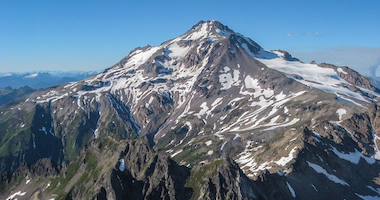



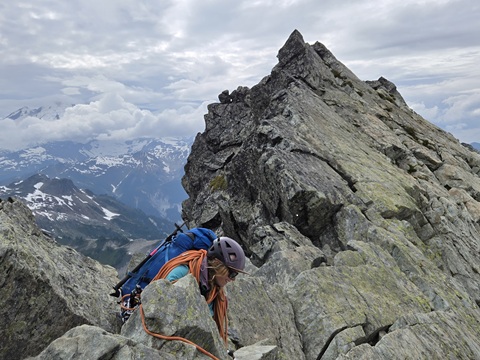
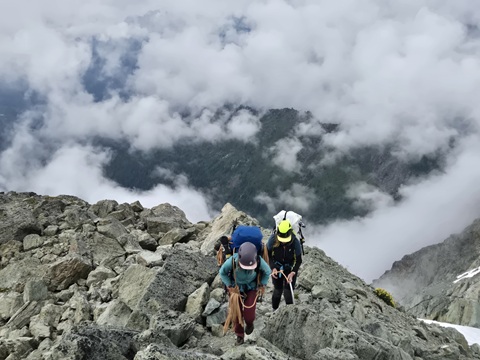
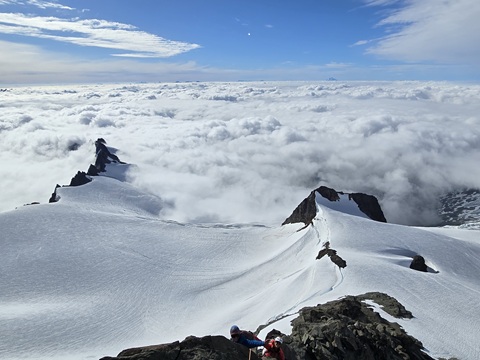
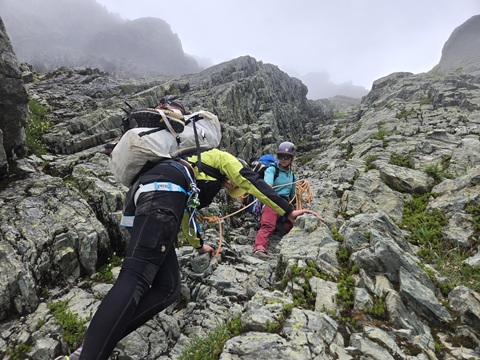
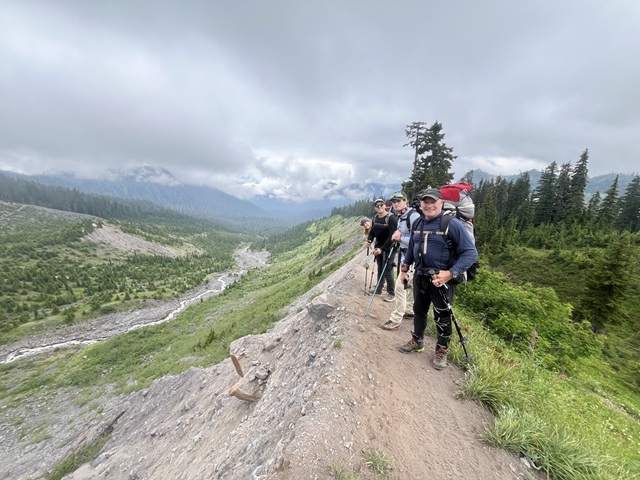
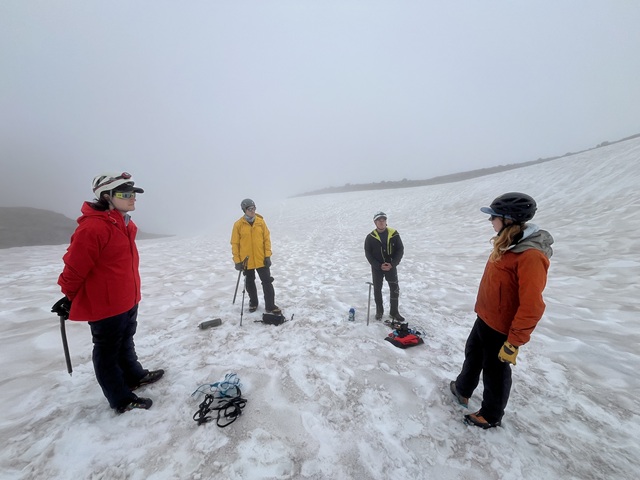
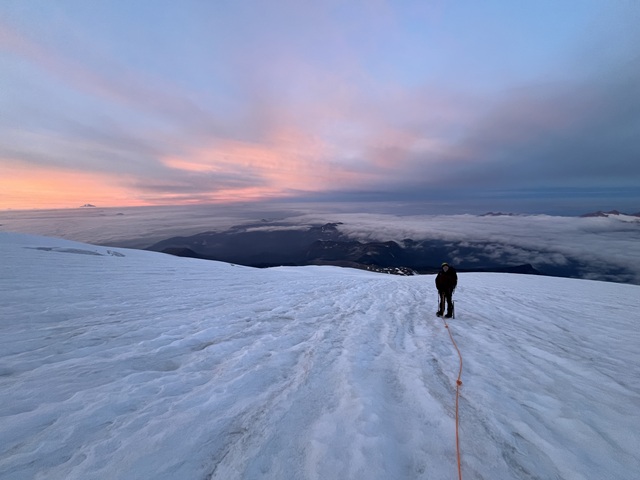
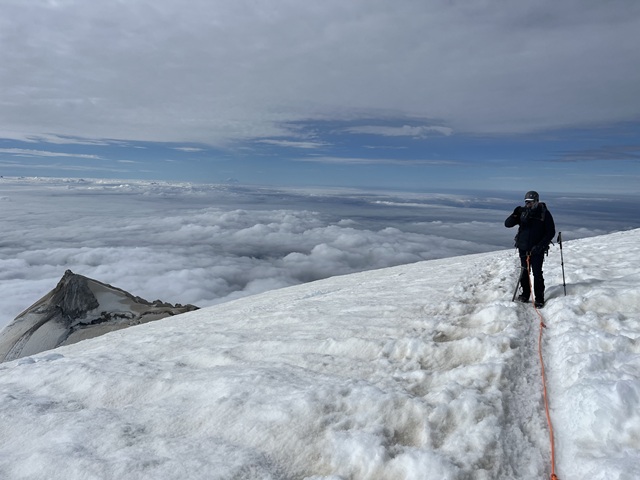
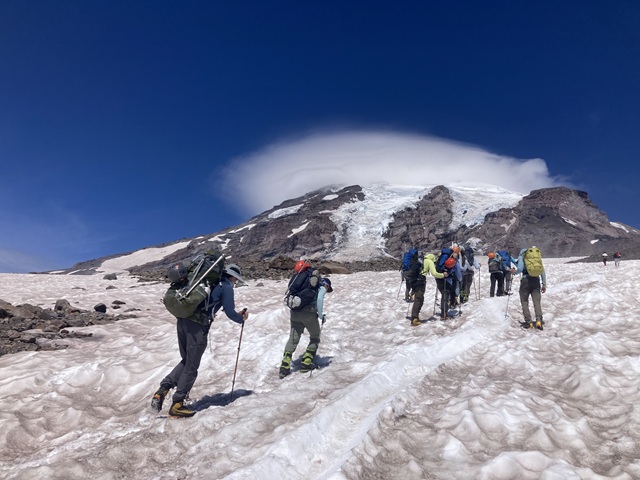
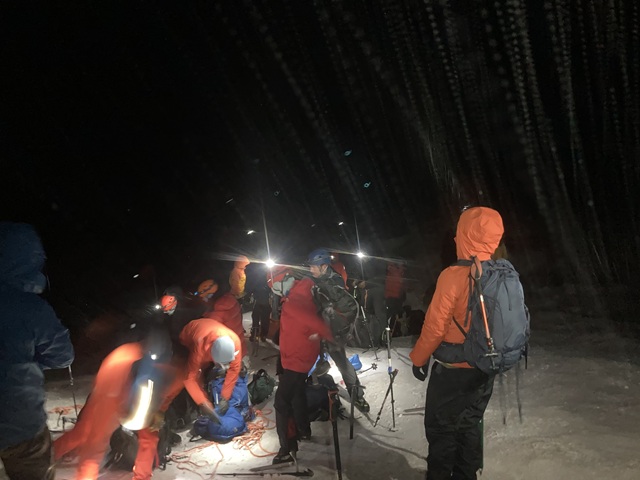
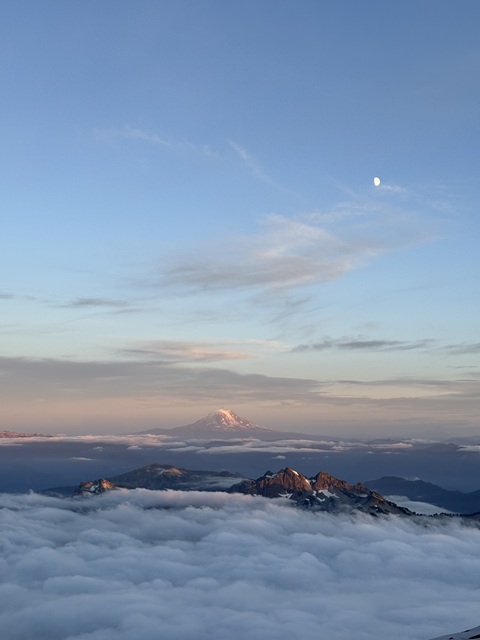
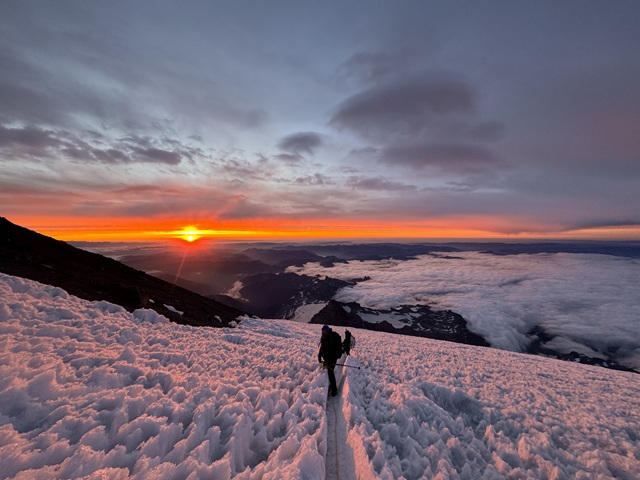
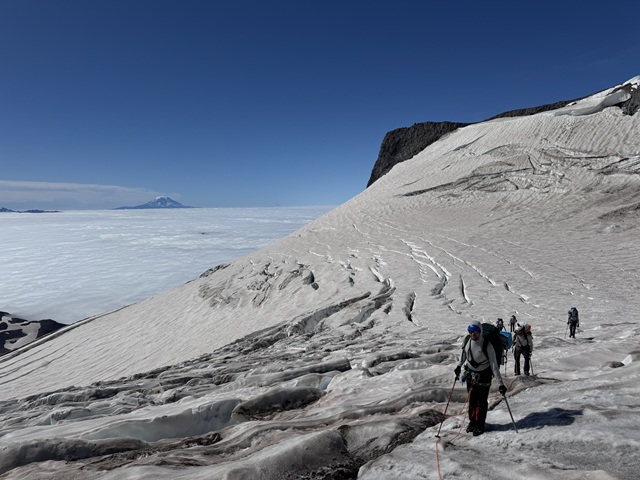
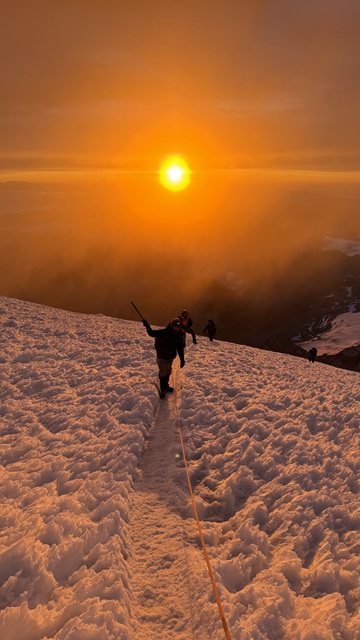
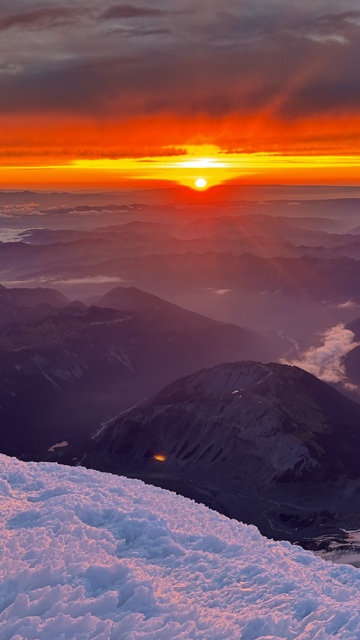
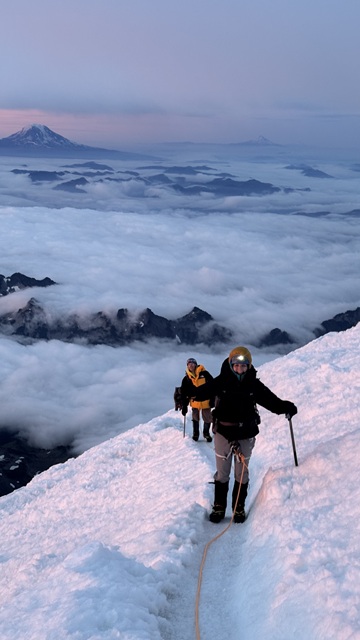
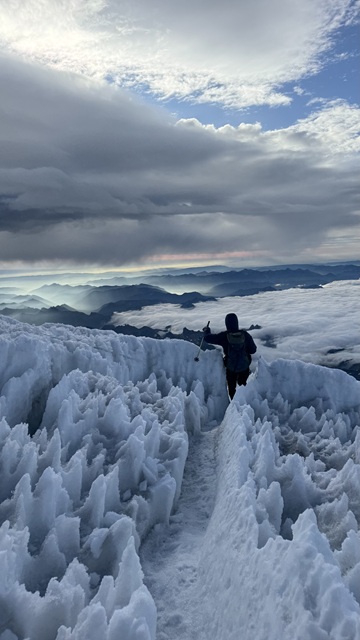
.jpg)
.jpg)
.jpg)
.jpg)
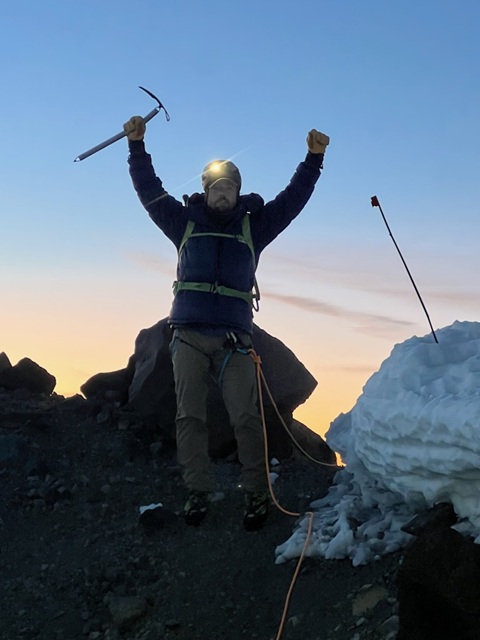
.jpg)
.jpg)
.jpg)






I will be praying Jim, for you and your team, that you have a safe trip.
Love Always,
Ann
Posted by: Ann Boyko on 5/6/2011 at 8:11 pm
View All Comments